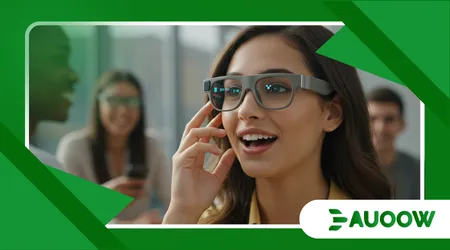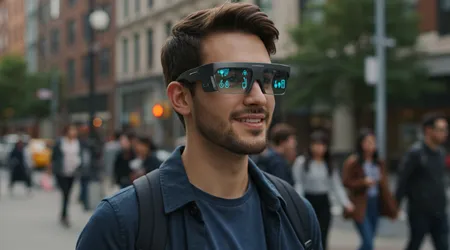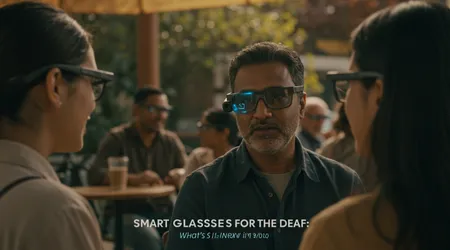Smart Glasses for the Deaf: What’s New in 2025

Smart glasses for the deaf are revolutionizing accessibility, blending cutting-edge technology with human-centric design to empower communication.
In 2025, these devices are no longer niche gadgets but pivotal tools for the Deaf and hard-of-hearing community, offering real-time captions, intuitive interfaces, and seamless integration into daily life.
This article dives into the latest innovations, exploring how smart glasses for the deaf are reshaping independence and inclusion, with a critical lens on their advancements, challenges, and future potential.
The Deaf community has long navigated a world designed for auditory communication, relying on lip-reading, sign language, or interpreters.
Assistive technologies like hearing aids have helped, but they often fall short in noisy environments or group settings.
Enter smart glasses for the deaf, which transcribe spoken words into text displayed on lenses, offering a transformative alternative.
In 2025, these devices are smarter, more accessible, and increasingly tailored to diverse needs, driven by AI advancements and user-focused design.
Why settle for partial solutions when technology can bridge gaps with precision? Let’s explore the breakthroughs defining this year.
The Evolution of Captioning Glasses
Captioning glasses have come a long way from clunky prototypes. Early models struggled with slow transcription and limited language support.
Today, smart glasses for the deaf leverage AI to deliver near-instantaneous captions, even in multilingual settings.
For example, imagine Sarah, a Deaf college student, attending a lecture. Her smart glasses for the deaf transcribe the professor’s words in real-time, displaying them on her lenses.
This allows her to follow complex discussions without an interpreter, fostering independence.
Recent advancements include improved speech recognition algorithms.
Companies like HearView have refined their systems to filter background noise, ensuring clarity in crowded spaces like cafes or conferences.
The integration of augmented reality (AR) has also elevated functionality.
++ How artificial intelligence is helping digital inclusion
AR overlays contextual information, such as speaker identification, making group conversations easier to follow for users like Sarah.
A 2025 report by HearView highlights that 78% of Deaf users prefer captioning glasses over traditional aids for their portability and discretion, underscoring their growing adoption.
However, challenges remain. High costs and battery life limitations can hinder accessibility, particularly for low-income users or those in developing regions.

Top Innovations in 2025
This year, smart glasses for the deaf are defined by bold innovations. Brands like HearView, Xander, and SubLinq are pushing boundaries with user-centric features tailored to the Deaf community.
HearView’s latest model offers customizable caption displays, allowing users to adjust font size and position for optimal readability during long sessions.
XanderGlasses stand out for their standalone capability, processing captions without a smartphone, which is ideal for users seeking minimal device dependency.
SubLinq’s “Deaf Mode” supports real-time transcription and translation across 20 languages, catering to multilingual environments like international conferences.
Also read: The impact of smart glasses on urban mobility
At CES 2025, Halliday AI smartglasses debuted with gesture-based controls, enabling users to navigate captions hands-free, enhancing usability in dynamic settings.
Battery life has improved significantly, with models like Rokid AR offering up to 8 hours of continuous use, addressing a common user complaint.
Yet, privacy concerns linger. Some glasses, like Meta’s Ray-Ban, collect voice data by default, raising ethical questions about user consent and data security.
| Brand | Key Feature | Battery Life | Price Range |
|---|---|---|---|
| HearView | Customizable captions | 6 hours | $500-$700 |
| XanderGlasses | Standalone processing | 7 hours | $600-$800 |
| SubLinq | Multilingual Deaf Mode | 5 hours | $450-$650 |
| Halliday AI | Gesture-based controls | 6.5 hours | $700-$900 |
Real-World Impact and User Stories
The impact of smart glasses for the deaf extends beyond technology it’s about empowerment. Take Michael, a Deaf barista who uses HearView glasses to communicate with customers.
Michael’s glasses transcribe orders in real-time, allowing him to focus on his craft rather than lip-reading in a noisy coffee shop environment.
In educational settings, these glasses are game-changers. Deaf students can engage in discussions without relying on interpreters, fostering a sense of belonging.
Read more: Electronic Braille: what it is and how it’s being used
A Stanford project, reported on X in April 2025, showcased student-designed smart glasses for the deaf that transcribe lectures, gaining traction for their affordability.
However, not all experiences are seamless. Users report occasional transcription errors in fast-paced conversations, highlighting the need for ongoing AI refinement.
Still, the emotional weight of independence is undeniable. For many, these glasses are like a bridge, connecting them to a world that once felt out of reach.
Challenges and Ethical Considerations
Despite their promise, smart glasses for the deaf face hurdles. Cost remains a barrier, with premium models priced between $500-$900, limiting access for many.
Battery life, while improved, can still falter during all-day use, frustrating users who rely on continuous transcription in professional settings.
Privacy is another concern. Glasses that collect audio data, like Meta’s Ray-Ban, risk misuse if companies fail to prioritize transparent data policies.
Cultural sensitivity matters too. Some Deaf users prefer sign language over captions, viewing technology as a supplement, not a replacement, for their identity.
Manufacturers must involve the Deaf community in design processes to ensure solutions align with diverse needs and respect cultural nuances.
Addressing these challenges requires collaboration between tech companies, policymakers, and advocacy groups to make smart glasses for the deaf truly inclusive.
The Future of Smart Glasses
Looking ahead, smart glasses for the deaf are poised for even greater leaps. AI advancements will likely enable near-perfect transcription accuracy by 2027.
Integration with neural interfaces could allow users to control glasses via thought, a concept Google teased at TED 2025 with its Android XR platform.
Affordability is a priority. Initiatives like Stanford’s low-cost prototype aim to democratize access, potentially reshaping the market by 2026.
Imagine a world where these glasses translate sign language into text for hearing users, fostering two-way communication an innovation SubLinq is exploring.
Sustainability is also key. Future models may use eco-friendly materials, aligning with growing consumer demand for ethical technology.
Ultimately, the future hinges on listening to Deaf users, ensuring their voices shape the next wave of assistive innovation.

Why This Matters Now
In 2025, smart glasses for the deaf are more than gadgets they’re catalysts for equity. They challenge a world built for auditory communication, offering inclusion.
Governments and organizations must support these technologies through subsidies and policies to ensure no one is left behind due to cost.
The Deaf community deserves tools that amplify their potential, not just their hearing. These glasses are a step toward that vision.
As technology evolves, so must our commitment to accessibility. Why wait to make the world more inclusive when solutions exist today?
By embracing these innovations, we’re not just advancing technology we’re advancing humanity, one conversation at a time.
Frequently Asked Questions
What are smart glasses for the deaf?
They’re wearable devices that transcribe spoken words into real-time text displayed on lenses, aiding communication for Deaf and hard-of-hearing individuals.
How much do they cost?
Prices range from $450-$900, depending on features like battery life and language support. Subsidies may be available in some regions.
Are they easy to use?
Most models are user-friendly, with customizable displays and gesture controls, though a learning curve exists for new users.
Do they work in noisy environments?
Yes, advanced models filter background noise, but accuracy may vary in extremely loud settings like concerts.
What’s the battery life like?
Typically 5-8 hours, sufficient for daily use, though heavy users may need midday charging.
This article reflects the latest advancements in smart glasses for the deaf, grounded in real-world insights and a commitment to accessibility.
Stay tuned for more updates as this technology continues to evolve.
